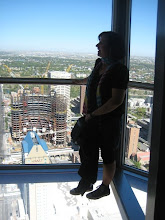This is the second time that I have attempted to complete this blog entry- damn Asian internet connection.....!
I wanted to make sure that I remembered as many details as possible regarding the Khmer Rouge as they are such an important part of Cambodian history. So here are all that I can freely recall...
The Khmer Rouge first started to become a problem in Cambodia around the late 60's/ early 70's, although local knowledge suggests that they were around for a lot longer than that. They were led by the dictator Pol Pot, who can only be likened to Hitler in his mad quest for power and world domination. Pol Pot believed that all those who consisted of the old regime in Cambodia- that is, those who were in charge before his demented takeover- should be removed and gotten rid of. He apparently believed that they were responsible for the difficulties in Cambodia, although in all honesty he was not interested in making life better for those poorer members of the public.
Pol Pot created 2 particular areas where he was able to rid Cambodia of the "filth" that consituted the old regime. One was Choeung Ek, more commonly known as the killing fields and the other was Tuol Sleng.
Choeung Ek was in the countryside and this was where most of the killings took place, so that members of the public would not be aware of what was going on. People would be arrested- sometimes for crimes such as wearing glasses- and taken to Choeng Ek. Here they were made to carry out very intense manual labour, working in the fields nearby, in order to provide good food for the guards. (Said guards were often their former friends and neighbours). The prisoners were often beaten, they got little or nothing in the way of food and they were often tortured. Men, women and children. The Rouge had many different ways of carrying out torture on their victims, but one of the favourites was to hold the head of the prisoner in a barrel of water until they became unconscious. They would then be revived by a flame being held to their face or feet, and the torture would begin again. The Rouge were not really looking for any information or anything that the prisoner could give them. They simply delighted in causing pain and distress to others. According to survivor accounts. the worst times would be in the middle of the night. Sometimes they would hear new trucks arriving, loaded with new prisoners. If the new people did not do as they were told they were simply shot on the spot. At other times the prisoners would be sleeping and the guards would enter the room, seizing anyone that took their fancy and dragging them out. The remaining prisoners would then hold their breath waiting for the terrible sound of the gunshots that would tell them that their fellow was dead. 17,000 corpses have been found thus far in the killing fields and the excavation is not yet complete. Many of the corpses found were those of children. No one seems able to say what crimes these kids had committed that led to their death in such terrible ways. The skulls and clothing of many of the victims are on display at Choeung Ek.
Tuol Sleng was a school until the Rouge took it over during their reign. It was then used as a holding prison for those who were not taken in to the country for whatever reason. The prisoners there were also starved beaten and tortured in many ways. When left in the cells they were chained constantly to the wall. The cells were made from brick and were tiny. They had to be used by the prisoners as a sleeping place- they are not big enough to lie down in-, as an eating place and as a toilet. The conditions were horrific. Tuol Sleng became particularly famous as it was where the Rouge held their final 14 prisoners, just beofre the Vietnamese broke into Cambodia and liberated it. The final 14 were found dead, having died in the most terrible of fashions. They were clearly starved and their bodies were found on the floors of their cells, having been eviscerated while they were still alive. The bodies included 4 women and 2 children under 5 years. Tuol Sleng is now a museum open to the public as is Choeung Ek and the final 14 have been laid to rest there.
Perhaps the most distressing element about this episode in Cambodia's past is that no one has been held to account for it. A war criminal trial is about to begin but in many cases it it too late. Pol Pot himself died in the late 90's- one can only hope that his death was neither peaceful or painless- and so have many of the other large names in this dreadful part of very recent history. They will never be held to account for the deaths that they caused (some estimate as many as 3 million). And the families of those who died will never have the satisfaction or closure of knowing that murderers have been brought to justice.
Subscribe to:
Post Comments (Atom)

No comments:
Post a Comment